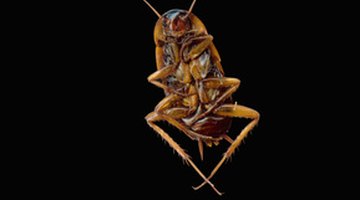How to Get Rid of Roaches in Texas
Texas might be home to the Cockroach Hall of Fame -- a quirky tourist attraction in Plano -- but the pests are welcome in few other buildings in the Lone Star State.

The state is home to a wide variety of roaches, including the small roaches that commonly infest urban areas across the United States and large, flying varieties that live along the Gulf Coast. Considering they multiply quickly and can contaminate food, you won't want any variety to be your guest for long.
Things You Will Need
- Adhesive roach traps
- Roach bait
- Powdered roach poison
- Aerosol roach poison
Identification
-
Determine what sort of roaches are the problem.
-
Use adhesive traps near places of suspected infestation. Check which species are in your house and determine the severity of the infestation.
-
Make your home as cockroach-unfriendly as possible, regardless of what species you have. Keep your home clean. Wash all dirty dishes. Clean up all food and crumbs. Seal garbage and pet food containers tightly.
Indoor Roaches
-
Use chemical measures to cull your roach population. Place store-bought bait near locations where you most often see roaches. Spread a light layer of powdered roach control products -- such as boric acid -- under your furniture. Concentrate on your refrigerator, areas around pipes and cracks and crevices near suspected populations. Spray small amounts of aerosol poison in hidden areas, away from areas where food preparation takes place. Spray it where you suspect roaches might take shelter.
-
Keep areas where you lay out bait particularly clean, since roaches are less likely to take the bait and spread it to their nests if they have other food sources.
-
Contact a pest control professional licensed by the Texas Department of Agriculture Structural Pest Control Service if you are unable to get rid of your roaches on your own.
Outdoor Roaches
-
Seal up all possible entryways for roaches. Fill in any cracks in your foundation or exterior walls wider than 1/8 inch. Reinforce seals around windows, doors and air conditioning units. Repair leaky pipes and cracked ceilings.
-
Move potential homes for outdoor roaches -- such as woodpiles, outdoor garbage dumpsters and other collections of debris -- as far away from your home or garage as possible.
-
Turn off lights around the outside of your home whenever possible to avoid attracting flying species of cockroaches.
Tip
Texas is home to about 30 species, but most are outdoor varieties. Two smaller species, the German cockroach and the brownbanded cockroach, like to make your home into their home. Both of these roaches are usually 1/2 inch to 5/8 inch long, but the German cockroach is light brown while the brownbanded cockroach is dark brown. Roaches longer than an inch, including species such as the American or Oriental cockroach, are primarily outdoor roaches that occasionally seek shelter in people's homes. Inspect anything you bring into your home -- luggage, groceries or furniture, for example -- for roaches or eggs to avoid a new infestation. Pesticides might offer some help in controlling outdoor roach populations, but the roaches often are too numerous and spread out for them to be effective.
Warning
Carefully read and follow instructions regarding any sort of roach poison, especially if you have children or pets.
The Drip Cap
- Texas might be home to the Cockroach Hall of Fame -- a quirky tourist attraction in Plano -- but the pests are welcome in few other buildings in the Lone Star State.
- The state is home to a wide variety of roaches, including the small roaches that commonly infest urban areas across the United States and large, flying varieties that live along the Gulf Coast.
- Determine what sort of roaches are the problem.
- Seal up all possible entryways for roaches.
- Move potential homes for outdoor roaches -- such as woodpiles, outdoor garbage dumpsters and other collections of debris -- as far away from your home or garage as possible.
References
Writer Bio
Michael Baker has worked as a full-time journalist since 2002 and currently serves as editor for several travel-industry trade publications in New York. He previously was a business reporter for "The Press of Atlantic City" in New Jersey and "The [Brazoria County] Facts" in Freeport, Texas. Baker holds a Master of Science in journalism from Quinnipiac University in Hamden, Conn.
Photo Credits
- jumping roach image by Adrian Hillman from Fotolia.com
- jumping roach image by Adrian Hillman from Fotolia.com
More Articles



